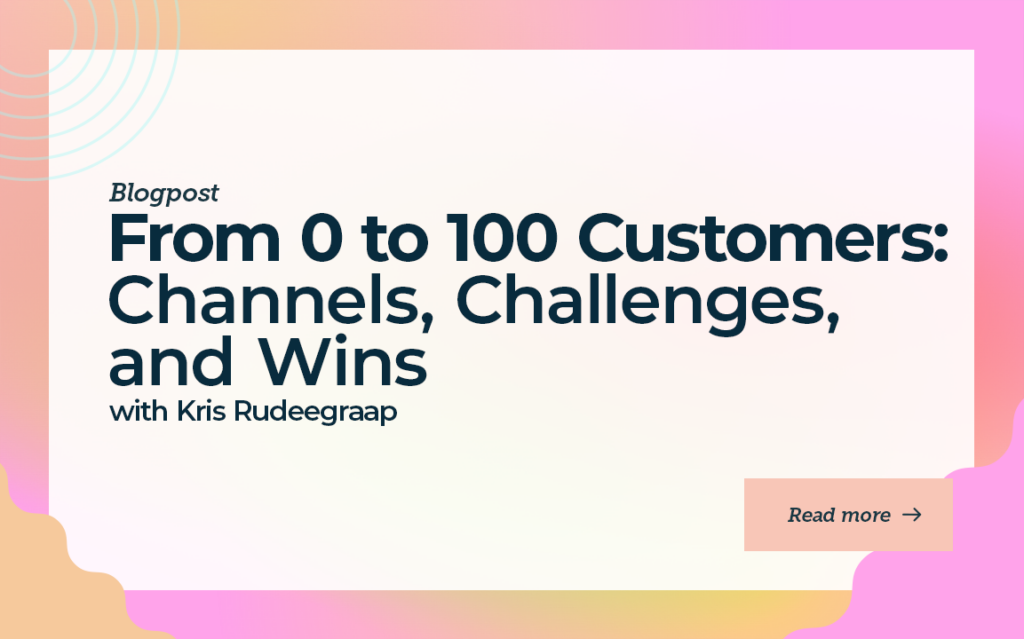From 0 to 100 Customers: Channels, Challenges, and Wins with Kris Rudeegraap

Sendoso‘s early success didn’t come from chance. It resulted from solving a real, overlooked pain point in the market. By blending founder-led outbound sales with a sharp understanding of buyer challenges, Co-founder Kris Rudeegraap and his team secured their first customers and laid the groundwork for scaling.
Find the Pain First
The easiest wins came from prospects already feeling the friction of manually sending gifts, swag, or direct mail. These early adopters didn’t need convincing. They knew the pain, hours wasted on boxing and tracking, and Sendoso’s value was immediately clear.
This approach is gold for sales teams trying to win their first customers: target prospects actively dealing with the problem your product solves. Instead of convincing them why the problem matters, you simply show them how you can remove the headache.
Creating Demand Where None Exists
Not every early customer will have felt the pain yet, though. For those prospects, Sendoso took a different path: educating the market. They turned skeptics into buyers by focusing on thought leadership, sharing proof points like case studies, and demonstrating how automating gifting could drive revenue.
This two-pronged strategy, targeting existing pain and creating new demand, helped Sendoso build a balanced inbound and outbound motion.
Sales leaders can learn a key lesson from this: balancing short-term wins with long-term education builds a sustainable foundation for growth.
Founder-Led Sales and Early Segmentation
When Sendoso set out to build its early revenue engine, Kris took a discovery-first approach. Instead of targeting a single group, they focused on two types of prospects:
- The Low-Hanging Fruit: Companies are already manually sending swag, gifts, or direct mail. These prospects immediately understood Sendoso’s value and converted quickly.
- The New Market: Prospects unfamiliar with direct mail automation but eager for new ways to drive revenue. This segment required more education and proof points.
By identifying pain points early in the sales process, they could tailor their approach, fast-tracking prospects who were ready to buy while nurturing those who needed more context.
Evangelism Meets Lead Generation
In addition to outbound, Kris leaned heavily on conferences to generate early traction. While events can seem risky for cash-strapped startups, the strategy paid off. Conferences served a dual purpose:
- Lead Generation: Direct interactions with prospects helped drive early deals.
- Brand Credibility: Positioning Sendoso alongside established brands created a “halo effect,” making the startup appear bigger and more credible.
With tireless execution, from collecting business cards to relentless follow-ups, Kris turned conferences into a high-impact growth lever.
Pricing, Packaging, and Growth
Sendoso’s growth relied on smart, multi-channel execution: outbound, events, partnerships, and content. But pricing missteps revealed key lessons. While an early low price created initial momentum, it skewed product-market fit signals. Raising rates later required a gradual increase to avoid churn, slowing expansion.
Looking back, the better approach?
Start with a higher price but heavily discount it for early adopters, framing it as a beta incentive. This will build credibility, validate value, and simplify pricing adjustments as the business scales.
Lessons in Early Scaling
Another overlooked area: Net Revenue Retention (NRR).
Focusing solely on ARR meant Sendoso prioritized new customer acquisition over expansion within existing accounts. Aligning product functionality and post-sale motions earlier would have driven stronger NRR and compounded revenue growth.
Lastly, a more iterative approach to pricing and packaging, such as experimenting with usage-based pricing, seat tiers, or multi-year commitments, could have unlocked more opportunities. For founders, regularly revisiting pricing models ensures long-term scalability and avoids leaving money on the table even when revenue is climbing.
Strategies for Sustainable Growth
Expanding is critical for founders aiming to double or triple revenue past the $1M mark. Prioritize NRR by identifying opportunities to grow within existing accounts. Combine this with a repeatable outbound engine, leveraging modern tools like Clay for enriched data and automated outreach at scale.
Don’t rely on a single channel. Diversify your demand generation strategy by testing outbound, partnerships, content, SEO, and events. Thoughtful partnerships, integrating with platforms like Outreach, HubSpot, or Salesforce, can extend reach and build credibility, while community building creates advocates who drive organic growth over time.
Finally, pricing matters. Start high, offer discounts for early adopters, and revisit models regularly. Low early pricing can create false signals of product-market fit and slow future growth.
Conclusion
Scaling beyond $1M requires more than effort. It takes strategic focus. Sendoso’s success highlights the value of solving immediate pain points while educating new markets to create demand. Balancing quick wins with long-term growth ensures both momentum and trust.
Prioritize customer insights, refine pricing early, and diversify demand generation. Founders can turn early traction into sustainable, scalable growth by aligning product, sales, and marketing strategies.
Ready to transform your outbound strategy? Explore how Sendoso‘s gifting and direct mail platform can drive pipeline and build connections.
Looking to build a repeatable sales engine? Partner with Predictable Revenue to scale your outbound motion and grow faster.
NO TIME TO READ?
Listen On:


